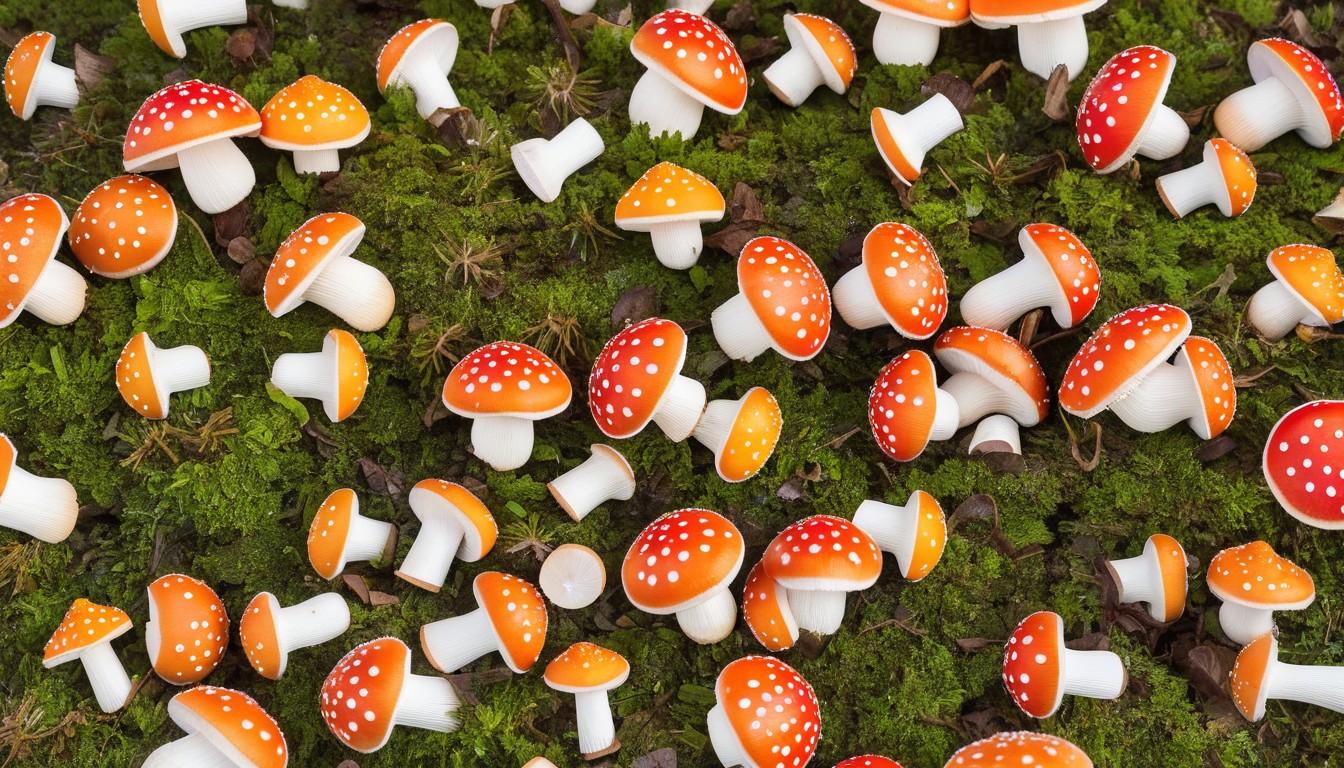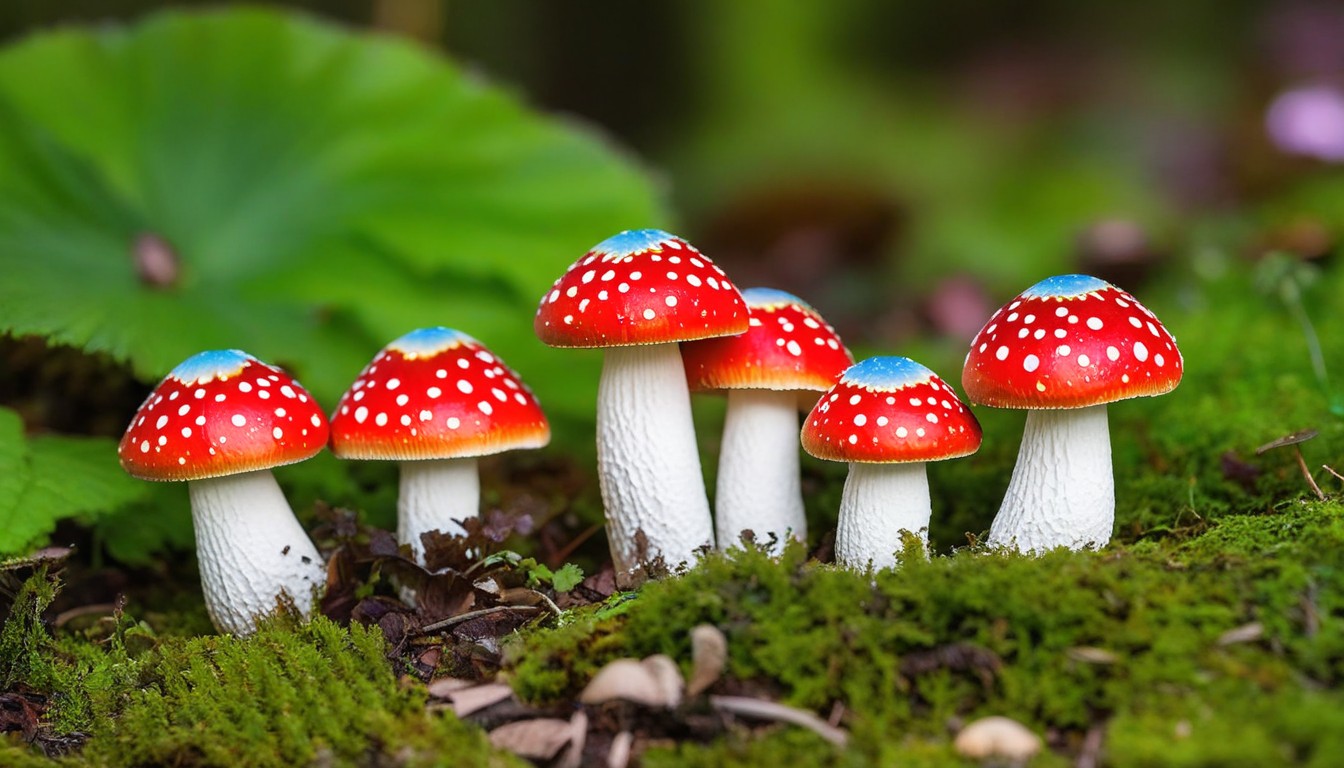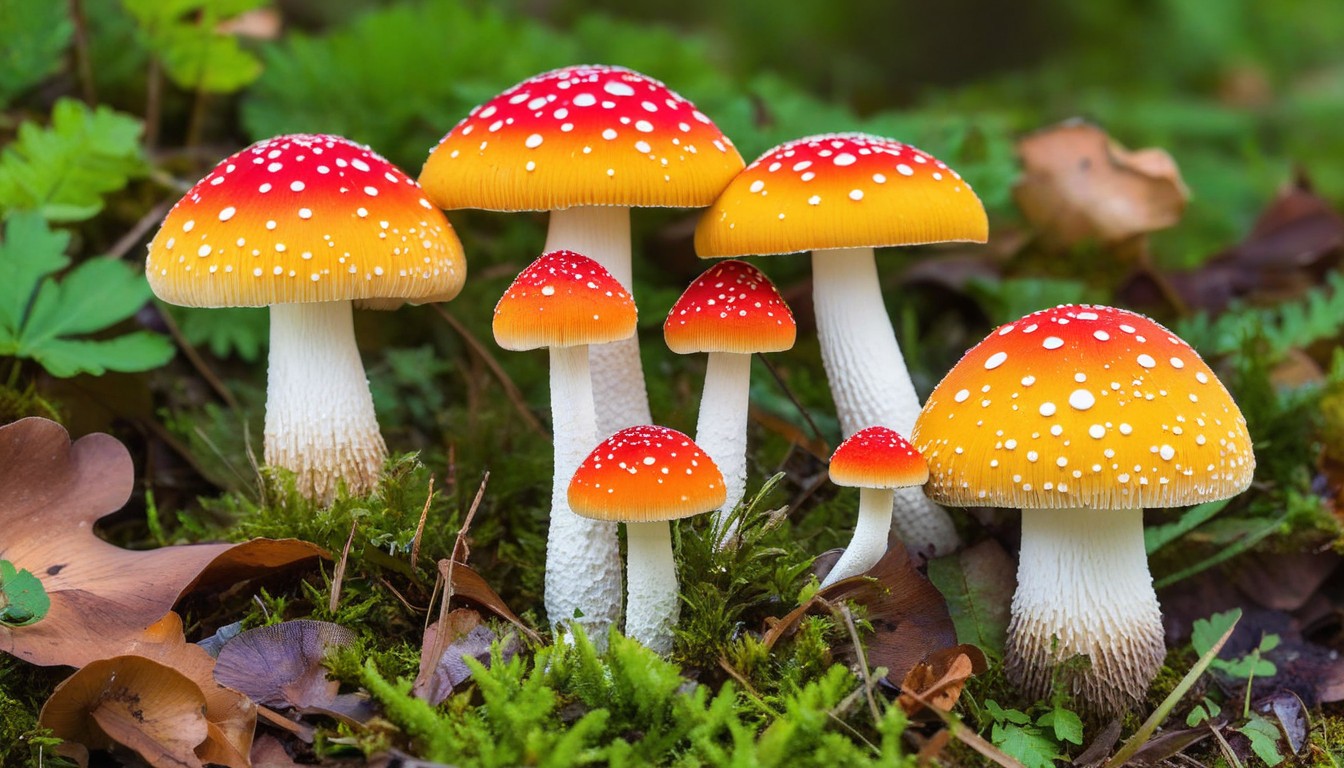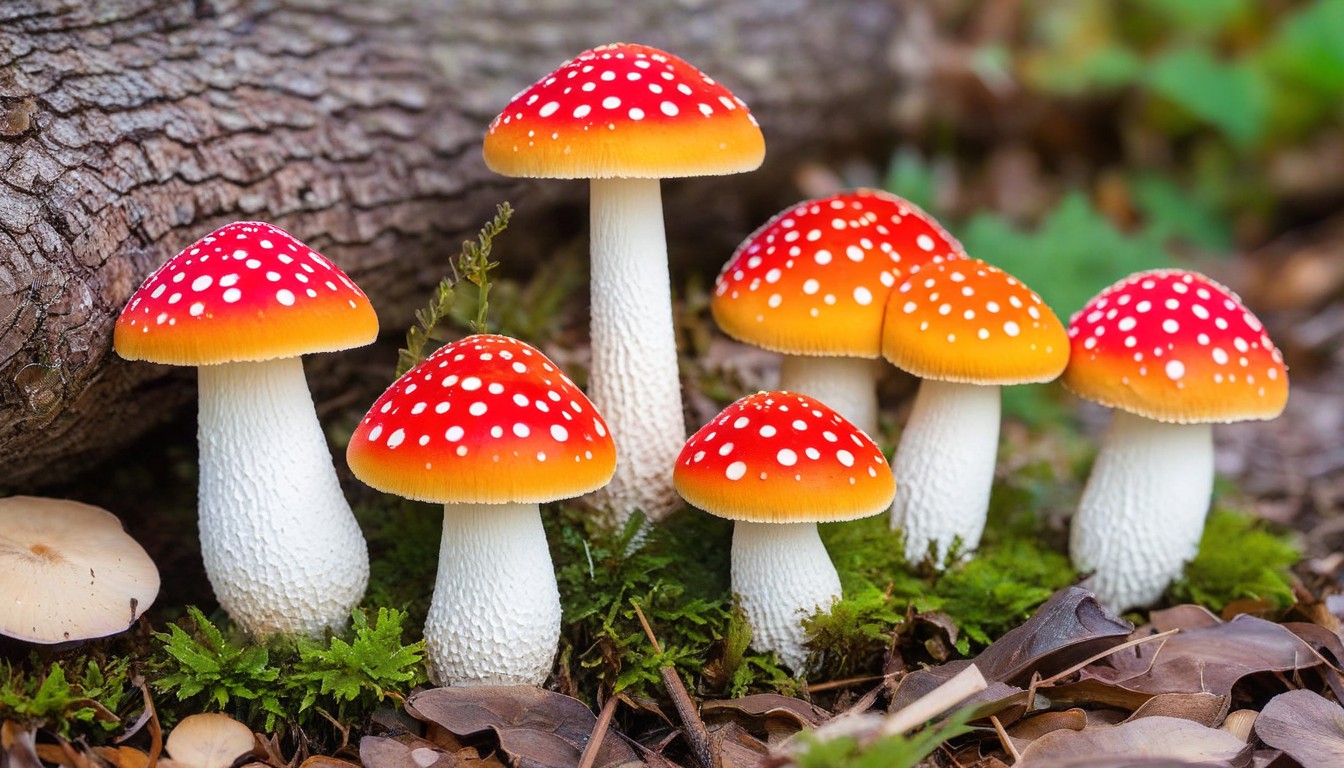Jawbreaker Mushrooms have taken the marine aquarium world by storm with their striking colors and easy care requirements. If you’re looking to add a pop of vibrancy and beauty to your underwater world, these mushrooms are a must-have. In this article, we will take a closer look at Jawbreaker Mushrooms and explore their vibrant hues, care requirements, and compatibility with other marine life. Get ready to dive into a colorful world of captivating mushrooms!
Key Takeaways
- Jawbreaker Mushrooms are a type of coral found in marine aquariums.
- They come in an array of stunning colors, adding a pop of vibrancy to any aquarium.
- Despite their delicate appearance, Jawbreaker Mushrooms are easy to care for.
- Proper nutrition, water quality, and aquarium setup are essential for their health and longevity.
- Compatibility with other marine life and propagation techniques are important considerations for Jawbreaker Mushroom care.
What Are Jawbreaker Mushrooms?
Are you ready to explore a world of stunning colors? Let’s dive into the fascinating world of Jawbreaker Mushrooms. These mushrooms are a type of coral that can be found in marine aquariums. They are known for their bold and vibrant hues, similar to the famous candy they’re named after.
But what exactly are they? Jawbreaker Mushrooms are a type of mushroom coral, scientifically known as Discosoma spp.. They belong to the Discosomatidae family and are native to the Indo-Pacific region.
If you’re looking for a colorful addition to your aquarium, Jawbreaker Mushrooms are an excellent choice.
One of the most interesting things about these mushrooms is that no two specimens are the same. Each one has a unique color pattern, making them a highly sought-after addition to any aquascape.
Are you ready to learn more about the vibrant colors of Jawbreaker Mushrooms? Let’s move on to the next section.
The Vibrant Colors of Jawbreaker Mushrooms
Jawbreaker Mushrooms are known for their stunning array of vibrant colors, making them a highly sought-after addition to any aquarium. These mushrooms have an impressive range of hues, from electric blues and greens to fiery reds and oranges.
Their vibrant colors are not just visually appealing but are also an indicator of their health and well-being. Bright and intense hues signify the presence of pigments that help the mushrooms absorb light for photosynthesis and protection against UV radiation.
One of the most fascinating aspects of Jawbreaker Mushrooms is that their colors can change over time, making them even more dynamic. This color change occurs due to factors such as changes in lighting, water conditions, and the mushroom’s growth process.
The Different Colors of Jawbreaker Mushrooms
|
Color |
Description |
|---|---|
|
Electric Blue |
One of the most popular and sought-after colors. |
|
Green |
Has several variations, ranging from bright neon green to a more subdued olive green. |
|
Red |
A vibrant shade of red or orange-red. |
|
Purple |
Can range from a deep, rich purple to a lighter lavender hue. |
|
Yellow |
Bright and sunny yellow or a softer, pastel shade. |
These vibrant colors make Jawbreaker Mushrooms an excellent choice for aquascaping, providing a pop of eye-catching color to any aquarium. Their unique characteristics and stunning appearance make them a favorite among aquarists.
In the next section, we will discuss the easy care tips for Jawbreaker Mushrooms, ensuring that they remain healthy and vibrant in your aquarium.
Easy Care Tips for Jawbreaker Mushrooms

While Jawbreaker Mushrooms may appear delicate, they are surprisingly easy to care for. Follow these simple tips to ensure your mushrooms thrive:
- Lighting: Provide moderate to high lighting, ideally between 150 to 250 PAR. Ensure the lighting schedule is consistent, with the recommended duration of 8 to 12 hours per day.
- Water Flow: Jawbreaker Mushrooms prefer gentle to moderate water flow. Place them in an area of the aquarium where they can receive an adequate flow without being blasted by strong currents.
- Water Quality: Maintain stable water parameters with a pH range of 8.0 to 8.4, salinity between 1.024 to 1.026 SG, and temperature between 75 to 80°F. Conduct regular water changes of 10 to 20 percent every two weeks to prevent the buildup of harmful substances.
- Feeding: Feed your Jawbreaker Mushrooms 1 to 2 times a week. They do not require any special feeding, but they will benefit from regular feedings of phytoplankton or reef-feeding zooplankton such as Cyclop-eeze.
- Handling: Handle Jawbreaker Mushrooms with care and avoid exposing them to air. When moving or fragging, make sure to keep them submerged.
“Jawbreaker Mushrooms may appear delicate, but they are surprisingly easy to care for.”
By following these easy care tips, you can enjoy the beauty of Jawbreaker Mushrooms without the stress of complicated maintenance. Keep in mind that each aquarium is unique, and sometimes it takes trial and error to find the perfect care routine for your mushrooms. Observe their reaction to changes and adjust accordingly, and soon enough, you’ll have a flourishing coral garden full of colorful Jawbreaker Mushrooms.
Jawbreaker Mushroom Aquarium Setup
Creating the perfect home for your Jawbreaker Mushrooms requires careful planning and attention to detail. Follow these steps to build a thriving environment for these beautiful coral mushrooms:
Selecting Your Tank
The first step is to choose an appropriately sized aquarium for your Jawbreaker Mushrooms. Plan for 10 gallons of water per mushroom. Keep in mind the requirements of any other marine life you plan to keep in the tank, as well as the space needed for proper filtration and lighting.
Equipment and Accessories
Invest in high-quality equipment to ensure optimal care for your mushrooms. This includes a protein skimmer, a sump, and a heater. Choose lighting that mimics natural daylight and provides adequate wavelengths for mushroom growth. Additionally, consider adding a powerhead for water circulation and a thermometer for accurate temperature readings.
Substrate and Live Rock
Add a layer of sand or crushed coral to the bottom of the tank to provide a natural substrate for your Jawbreaker Mushrooms. Live rock is also beneficial for providing hiding spots and a source of natural filtration.
Water Conditions
Maintaining proper water conditions is crucial for the health of your Jawbreaker Mushrooms. Aim for a salinity level of 1.025 and a pH level between 8.1 and 8.4. Test water parameters regularly and perform regular water changes to keep the water quality pristine.
Arranging Your Mushrooms
When it comes to placing your Jawbreaker Mushrooms in the tank, consider their unique needs. Provide ample space between each mushroom to ensure they have room to grow and prevent territorial battles. Place the mushrooms on the substrate or on live rock, preferably in a position that mimics their natural environment.
By following these simple steps, you can provide your Jawbreaker Mushrooms with the ideal environment for their growth and beauty.
Feeding Jawbreaker Mushrooms

Proper nutrition is crucial to maintain the health and vibrant colors of Jawbreaker Mushrooms. These mushrooms are photosynthetic and require both light and nutrients to thrive. Here are some tips on feeding your Jawbreaker Mushrooms:
- Provide adequate lighting: Jawbreaker Mushrooms require moderate to high lighting to grow and produce food through photosynthesis. Ensure that your aquarium lighting is appropriate for the type of mushroom you have.
- Feed regularly: While Jawbreaker Mushrooms can survive on photosynthesis alone, they will benefit from regular feedings. Offer small amounts of food to your mushrooms twice a week, using a coral feeding syringe or pipette.
- Choose the right food: Jawbreaker Mushrooms are omnivores and will consume both meaty and plant-based foods. Offer them a variety of small marine organisms such as brine shrimp, zooplankton, and phytoplankton.
- Avoid overfeeding: Overfeeding can lead to poor water quality and harm both your mushrooms and other marine life in your aquarium. Ensure that you only provide enough food that can be consumed within a few minutes.
By following these feeding tips, you can ensure that your Jawbreaker Mushrooms remain healthy, colorful, and continue to enhance the beauty of your aquarium.
Maintaining Water Quality for Jawbreaker Mushrooms
Water quality is crucial for keeping Jawbreaker Mushrooms healthy and vibrant. Here are some tips to maintain optimal water conditions:
- Regular testing: Regularly test the water parameters of your aquarium using a reliable test kit to ensure the levels of ammonia, nitrite, nitrate, pH, and salinity are within the appropriate range.
- Water changes: Change 10% to 20% of the water every week to remove toxins and excess nutrients from the aquarium. Vacuum any debris or uneaten food that may have settled on the substrate.
- Proper filtration: Use a filter that is appropriate for the size of your tank and the bioload of your marine animals. Ensure your filter is working optimally and doesn’t require frequent cleaning.
- Avoid overfeeding: Overfeeding can increase the amount of waste and nutrients in the water, leading to poor water quality. Feed your Jawbreaker Mushrooms and other inhabitants of the aquarium appropriate amounts of food, and remove any uneaten food after 10 to 15 minutes.
By following these tips, you can maintain a clean and healthy environment for your Jawbreaker Mushrooms, ensuring they thrive and add a stunning touch to your aquatic world.
Propagation Techniques for Jawbreaker Mushrooms

Jawbreaker Mushrooms are a popular choice for aquarium enthusiasts, due to their colorful and unique appearance. They also multiply quickly, making them an appealing option for breeders. In this section, we’ll explore different propagation techniques to help you successfully grow and breed more Jawbreaker Mushrooms.
Fragmentation
One of the most common propagation methods for Jawbreaker Mushrooms is fragmentation. This technique involves carefully cutting the mushroom into smaller pieces and allowing each fragment to heal and grow into a new mushroom.
Note: Before attempting this method, make sure your mushroom is healthy and large enough to be divided.
Here’s how to fragment your Jawbreaker Mushroom:
- Remove the mushroom from the aquarium and place it on a flat surface.
- Use a sharp, sterile razor blade to cut the mushroom into two or more pieces. Each piece should be at least one inch in size.
- Allow the fragments to heal for at least two to three weeks before placing them back into the aquarium.
- During this time, keep the fragments in a low-flow area with indirect lighting.
- Once the fragments have fully healed, they can be placed back into the aquarium.
Division
Division is another propagation technique that involves separating the mushroom into multiple sections, each with its own mouth and skeleton. This method is ideal for larger Jawbreaker Mushrooms that have already formed multiple mouths.
Here’s how to divide your Jawbreaker Mushroom:
- Remove the mushroom from the aquarium and place it on a flat surface.
- Identify the areas where natural division has occurred, and gently pull the mushroom apart at these points.
- Each divided section should have its own mouth and skeleton.
- Allow the divided sections to heal for at least two to three weeks before placing them back into the aquarium.
- During this time, keep the sections in a low-flow area with indirect lighting.
- Once the sections have fully healed, they can be placed back into the aquarium.
Propagation of Jawbreaker Mushrooms is a great way to expand your coral collection, and these techniques are simple enough for even novice aquarists to attempt. With proper care and patience, you can successfully breed and grow these stunning mushroom corals in your own aquarium.
Compatibility with Other Marine Life
Before adding Jawbreaker Mushrooms to your aquarium, it is crucial to consider their compatibility with other marine life. Although they are generally peaceful creatures, some species may have natural tendencies to sting or compete for space. At worst, they may even harm or get harmed by their tank mates.
Keep in mind that Jawbreaker Mushrooms require specific water parameters, which may not be suitable for some creatures. For example, they prefer low to moderate water flows, which can be too still for some fish.
To ensure a harmonious aquatic environment for your Jawbreaker Mushrooms, you should choose suitable tank mates and consider their behavior, size, and diet. Here are some examples:
“Compatible tank mates for Jawbreaker Mushrooms include species of clownfish, wrasses, gobies, and tangs. These fish are generally peaceful and do not pose a threat to the mushrooms. However, avoid adding aggressive or territorial fish, as they can harm both the mushrooms and other marine life in your aquarium.”
It is also important to avoid overcrowding your aquarium, as this can lead to increased competition for resources and territorial disputes. Aim for a maximum of one mushroom per gallon of water.
Finally, observe the behavior of your Jawbreaker Mushrooms and their tank mates regularly to ensure they all live in a healthy and stress-free environment. If you notice any signs of aggression or stress, take appropriate measures to prevent harm to your marine life.
Common Challenges and Troubleshooting

While Jawbreaker Mushrooms are relatively easy to care for, they may encounter certain challenges that could affect their health and growth. Below, we’ve listed some common issues and their possible solutions:
Discoloration
If you notice your Jawbreaker Mushrooms losing their vibrant colors or turning brown, it could be a sign of stress or poor water quality. Check the water parameters and make sure they are within the recommended range. You may also want to consider adjusting the lighting or moving the mushrooms to a different spot in the tank. If the problem persists, it could be a sign of a deeper issue, and seeking advice from a professional is recommended.
Pests
Jawbreaker Mushrooms can sometimes fall prey to pests such as flatworms or nudibranchs. If you notice these creatures on your mushrooms, consider removing them manually or using a pest control treatment specifically designed for coral mushrooms. Be sure to follow the instructions carefully and monitor your mushrooms closely afterwards.
Diseases
Like any living organism, Jawbreaker Mushrooms can be vulnerable to diseases. If you notice your mushrooms looking unhealthy or displaying unusual behavior, it’s important to act quickly to prevent the disease from spreading to other marine life in the tank. Quarantining the affected mushrooms and treating them with a coral dip or medication may help, but seeking professional advice is recommended to ensure proper diagnosis and treatment.
By identifying and addressing common challenges that Jawbreaker Mushrooms may face, you can help ensure their health and longevity in your aquarium.
Enhancing Your Aquarium with Jawbreaker Mushrooms
Adding Jawbreaker Mushrooms to your aquarium not only introduces a burst of vibrant colors but also enhances the overall aesthetic appeal. These captivating mushrooms can be incorporated in various ways to create a stunning underwater masterpiece. Here are some creative ideas to enhance your aquarium with Jawbreaker Mushrooms:
Create a Mushroom Garden
A mushroom garden is an excellent way to showcase the beauty of Jawbreaker Mushrooms. Plant them in clusters of varying colors and sizes in one area of your aquarium to create a mesmerizing focal point. Use live rock as a base and attach the mushrooms using reef-safe glue or fishing line. Be sure to space them out evenly to prevent overcrowding and to give them ample room to grow.
Use Them as a Colorful Background
Jawbreaker Mushrooms can also be used effectively as a colorful background in your aquarium. Place them behind other corals or aquatic plants as a vibrant and textured backdrop. The different colors and heights of the mushrooms will create a striking contrast against the other elements in your aquarium.
Pair Them with Other Colorful Marine Life
To enhance the colors of your Jawbreaker Mushrooms even further, pair them with other marine life in complementary hues. For example, place green mushrooms next to purple tube anemones, or red mushrooms next to yellow tangs. The result will be an explosion of color that will make your aquarium truly mesmerizing.
Highlight Them with LED Lighting
LED lighting is a great way to highlight the vibrant colors of your Jawbreaker Mushrooms. Install lights strategically around them to create a dramatic effect. Choose lighting that can be adjusted to different colors and intensities for even more versatility.
Combine Them with Sand and Shells
Incorporate natural elements like sand and shells to create an aquatic landscape that highlights the beauty of Jawbreaker Mushrooms. Place colorful mushrooms on top of white sand and add shells around them to create a beach-inspired scene. This will not only enhance the colors of the mushrooms but also create a visually appealing environment for your marine life.
By incorporating Jawbreaker Mushrooms in various ways, you can create a visually stunning and unique aquarium. Experiment with different colors, heights, and placements to discover your ideal combination. With their vibrant hues and easy care requirements, Jawbreaker Mushrooms are an excellent addition to any aquarium.
Conclusion
Jawbreaker Mushrooms are a stunning addition to any marine aquarium. Their vibrant colors and unique characteristics make them a fascinating subject to explore. We hope this article has provided you with valuable insights into the world of Jawbreaker Mushrooms.
By following the easy care tips and aquarium setup guidelines, you can ensure the health and longevity of your Jawbreaker Mushrooms. Remember to maintain optimal water conditions, provide proper nutrition, and address any challenges that may arise.
With their compatibility with other marine life, Jawbreaker Mushrooms can be a stunning addition to any aquascape design. Whether you’re a seasoned aquarist or a beginner, Jawbreaker Mushrooms offer a mesmerizing opportunity to enhance the beauty of your aquarium.
Thank you for joining us on this journey through the colorful world of Jawbreaker Mushrooms. We hope you enjoy the experience of keeping these unique coral mushrooms in your aquarium.
FAQ
What are Jawbreaker Mushrooms?
Jawbreaker Mushrooms are a type of coral found in marine aquariums. They are known for their vibrant colors, resembling the popular candy with the same name.
What makes Jawbreaker Mushrooms unique?
Jawbreaker Mushrooms stand out due to their vibrant hues and captivating appearance. They add a pop of color to any aquarium and enhance its beauty.
How do I care for Jawbreaker Mushrooms?
Caring for Jawbreaker Mushrooms is relatively easy. Ensure they have the right water conditions and lighting, and they will thrive in your aquarium.
What is the ideal aquarium setup for Jawbreaker Mushrooms?
To create the perfect environment for Jawbreaker Mushrooms, select an appropriate tank size and arrange the necessary equipment for their needs.
What should I feed Jawbreaker Mushrooms?
Jawbreaker Mushrooms require proper nutrition. Feed them with their preferred types of food and ensure they receive regular meals.
How do I maintain water quality for Jawbreaker Mushrooms?
Maintaining optimal water quality is crucial for the well-being of Jawbreaker Mushrooms. Regularly test water parameters and take steps to maintain pristine conditions.
How can I propagate Jawbreaker Mushrooms?
You can propagate Jawbreaker Mushrooms through techniques such as fragmentation and division. These methods will help you breed and grow more of these stunning coral mushrooms.
Are Jawbreaker Mushrooms compatible with other marine life?
It is essential to consider the compatibility of Jawbreaker Mushrooms with other marine life before introducing them to your aquarium. Some species make better tank mates than others.
What are common challenges associated with Jawbreaker Mushrooms?
Common challenges for Jawbreaker Mushrooms can include discoloration, pests, and diseases. Learn how to identify and resolve these issues to ensure the health of your mushrooms.
How can Jawbreaker Mushrooms enhance my aquarium?
Jawbreaker Mushrooms not only bring vibrant colors to your aquarium but also enhance its overall aesthetic appeal. Explore creative ways to incorporate these captivating mushrooms into your aquascape.

